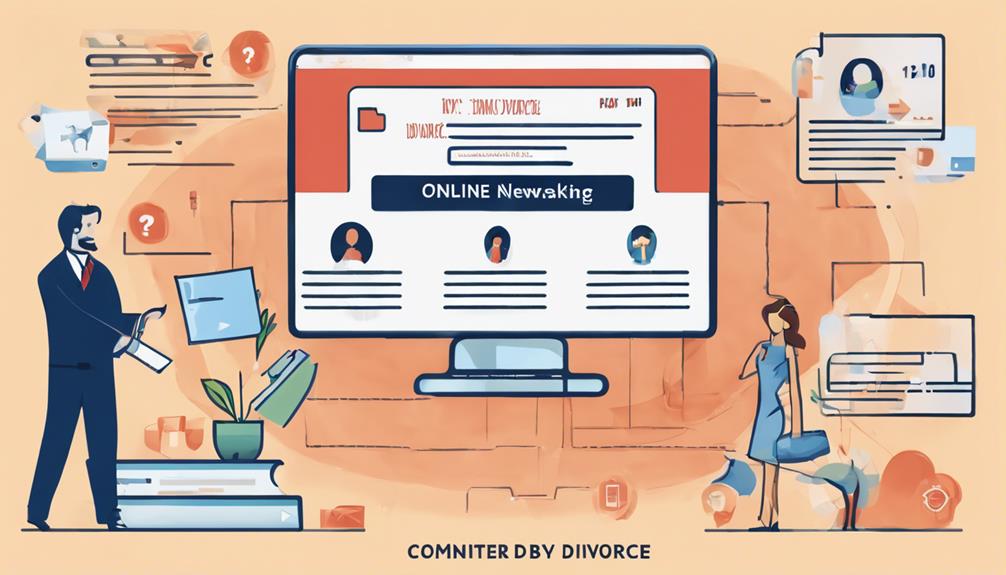Navigating the process of divorce without a lawyer is like standing at a crossroads, where each decision you make paves the way for a fresh start in your life.
The path to ending a marriage without a lawyer can be daunting, yet empowering. With each step, we will unravel the complexities of the process and uncover the tools needed to navigate this terrain successfully.
So, are you ready to take the first step towards a new beginning?
Key Takeaways
- Meet residency requirements before filing to ensure jurisdiction.
- Accurately complete and file necessary paperwork for divorce proceedings.
- Serve the Original Petition correctly to notify the other party formally.
- Utilize resources for fee waivers and legal guidance during the process.
Understanding Residency Requirements
Understanding the residency requirements for divorce is crucial before initiating the legal process to ensure compliance with both state and county regulations.
In Texas, the state residency requirement mandates that at least one party must have been a resident for the last six months. Additionally, for the divorce process to commence, either spouse must have lived in the county where they're filing for divorce for the preceding 90 days.
Meeting both the state and county residency requirements is paramount as failure to do so can lead to significant delays or even dismissal of the divorce case. These residency requirements play a critical role in determining the jurisdiction where the divorce proceedings will take place.
Properly establishing residency ensures that the court has the authority to handle the divorce case and that all legal proceedings are conducted in the appropriate location according to Texas law. Understanding and adhering to these residency requirements are fundamental steps in initiating a divorce in Texas.
Filing the Original Petition

When filing the Original Petition, we need to ensure accuracy and completeness in the forms to avoid delays or complications in the divorce process.
It's crucial to file the necessary paperwork with the court and provide copies to the other party to comply with legal requirements.
Serving the other party with the Original Petition initiates the formal notification process and sets the divorce proceedings in motion.
Prepare Necessary Forms
To initiate the divorce process in Texas, the first crucial step is preparing and filing the Original Petition, which serves as the official document to begin proceedings. When preparing the necessary forms, it's essential to ensure accuracy as errors could lead to delays in the filing process. The Original Petition should include detailed information such as the grounds for divorce, details regarding children involved, the division of property, and the relief sought. Filing the Petition in the correct district court where either spouse resides is vital for a smooth process. Remember that filing this document also triggers the mandatory 60-day waiting period in Texas before the divorce can be finalized.
Accuracy is key for a seamless process.
Providing detailed information is crucial.
Filing in the correct district court is essential.
File With Court
Filing the Original Petition for Divorce with the appropriate district court is the initial step to officially kickstart the divorce process in Texas without the need for a lawyer. This document, the Original Petition for Divorce, is crucial as it outlines key details about the marriage, reasons for the divorce, and the relief being sought.
It's essential to file this petition in the correct district court where one of the spouses meets the residency requirements. When completing the Original Petition, accuracy and completeness are paramount to ensure a smooth divorce process without legal representation.
Serve the Other Party
Serving the other party with a copy of the Original Petition for Divorce is a crucial step to ensure their awareness of the divorce proceedings. The Original Petition outlines the grounds for divorce and the relief being sought. Proper service can be achieved through personal delivery, certified mail, or a process server.
This legal process initiates the proceedings and allows the other party to respond to the petition. Ensuring that the other party is properly served is vital for the divorce process to move forward smoothly and for both parties to have the opportunity to address the issues at hand. It's a fundamental aspect of the law that must be meticulously followed.
Obtaining Spouse's Response

Upon receiving the necessary documentation from the spouse, we can proceed with incorporating their response into the uncontested divorce process. Communication plays a vital role in ensuring a smooth transition through this phase.
The spouse has the option to either waive service by signing a Waiver of Service Only form or file a Respondent's Original Answer to address the Petition. It's crucial to seek the spouse's cooperation during this stage as their response can significantly impact the timeline and outcome of the divorce process.
Timely submission of the spouse's response is essential to avoid unnecessary delays. By actively engaging with the spouse and encouraging open communication, both parties can work towards a mutually agreeable resolution.
Understanding the importance of the spouse's role in this process can help facilitate an uncontested divorce, leading to a more efficient and amicable dissolution of the marriage.
Completing Final Decree Form

When completing the Final Decree Form, we must ensure that all required information is accurately provided. Filling out the details correctly is crucial to avoid any misunderstandings or discrepancies.
Once the form is completed, it's essential to thoroughly review it and have both parties sign to finalize the divorce agreement.
Required Information for Form
What specific details are required when completing the Final Decree of Divorce form? When filling out this crucial document, ensure to include the following key information:
- Detailed property division to outline who gets what assets.
- Clear child custody arrangements specifying parental responsibilities.
- Comprehensive disclosure of assets, debts, and income to facilitate fair distribution.
Providing accurate data on child support and visitation schedules is essential for the well-being of the children involved. Remember, the Final Decree of Divorce form must meet legal requirements and be signed by both parties for the court's approval.
Paying close attention to these specifics can streamline the divorce process and ensure a smoother transition for all parties.
Filling Out Details Accurately
To ensure the accurate completion of the Final Decree of Divorce form, it's crucial to meticulously detail the provisions related to property division, child custody, and support in alignment with the agreed terms between both spouses. Providing accurate information on these key aspects is essential to prevent disputes or delays in the divorce process.
Both parties must thoroughly review and agree on the finalized details before submitting the form to the court. It's important to ensure that all relevant information is correctly documented to facilitate a smoother review process by the judge. By accurately filling out the Final Decree of Divorce form with the agreed-upon terms, you increase the likelihood of obtaining the judge's approval efficiently.
Reviewing and Signing Form
Upon carefully reviewing the Final Decree of Divorce form, both spouses should promptly proceed to sign the document to affirm their agreement on the outlined terms. The Final Decree encapsulates crucial aspects such as property division, child custody, visitation rights, and support, making it imperative to review all details meticulously before signing.
This step signifies a mutual understanding and acceptance of the agreed-upon terms, setting the stage for the legal process to move forward smoothly. Once signed, the Final Decree will be presented to the judge for review to ensure compliance with legal standards.
Signing this document is a pivotal moment in the divorce proceedings, signifying a commitment to the decisions made and paving the way for the finalization of the divorce without legal representation.
Waiting Period and Court Appearance

During the divorce process in Texas, a mandatory 60-day waiting period must be observed from the date of filing before the finalization of the divorce. This waiting period allows for reflection and the possibility of reconciliation before the divorce is granted.
At the final hearing, both parties are required to appear in court to have the divorce decree approved by the judge. These court appearances are essential to ensure that the divorce terms are fair and meet all legal requirements. It also provides an opportunity for any final discussions or clarifications before the divorce is officially granted.
The court appearance is a crucial step in the divorce process, allowing both parties to present their case and address any outstanding issues before the divorce is finalized. It's important to attend the final hearing as scheduled to ensure a smooth and successful resolution of the divorce proceedings.
Finalizing the Divorce Decree

When finalizing the divorce decree, it's crucial to review the contents meticulously to ensure accuracy and completeness. Signatures and dates must be affixed by both parties to make the decree legally binding.
Filing the decree with the court officially marks the end of the divorce process and sets the agreements into motion.
Decree Contents Review
In finalizing the divorce decree, we must ensure that all terms and agreements regarding property division, child custody, visitation, and support are accurately documented and compliant with Texas family law requirements. The Final Decree of Divorce holds significant weight in the legal process, detailing crucial aspects that impact both parties' futures. It's essential to prioritize fairness and the well-being of any children involved when outlining these agreements. The judge's approval of the Final Decree is necessary to officially conclude the divorce proceedings, making it imperative to adhere to all legal guidelines and requirements.
- Fair distribution of marital property and debt is crucial.
- Considerations for the children's best interests must be a top priority.
- Refusal to sign the Final Decree may lead to legal consequences and further complications.
Signatures and Dates
To finalize the divorce decree, both spouses must provide their signatures and dates, officially solidifying the agreed-upon terms regarding property division and child custody arrangements. The Final Decree serves as a conclusive document outlining the decisions made by both parties and becomes legally binding once signed and dated.
Notarizing the signatures on the Final Decree adds an extra layer of authentication, ensuring the validity of the divorce agreement. The dates on the Final Decree indicate when the court officially recognizes the terms of the divorce agreement.
Property division and child custody arrangements are key components detailed within the Final Decree, reflecting the decisions reached by the spouses. It's essential for both parties to carefully review, sign, date, and notarize the Final Decree to complete the divorce process.
Filing the Decree
Filing the Final Decree of Divorce involves submitting the document to the court for official approval, marking the conclusive step in solidifying the divorce settlement. The Final Decree of Divorce is a crucial document that outlines agreements on property division, child custody, visitation rights, and financial support.
Here are three emotional considerations to keep in mind during this process:
- Ensuring the best interests of any children involved
- Reflecting on the past while looking towards a new future
- Navigating the complex mix of emotions that may arise
It is essential that the Final Decree of Divorce accurately reflects the agreements made between both parties and is submitted for court approval to become legally binding.
Mediation and Negotiation Tips

Let's delve into essential mediation and negotiation tips that can significantly aid in reaching amicable agreements during a divorce process. Mediation offers a valuable opportunity to resolve disputes amicably, with over 75% of mediated divorces resulting in settlement agreements. When engaging in negotiation, it is crucial to focus on interests rather than positions, utilize objective criteria for decision-making, and maintain open communication throughout the process. Mediation costs are generally lower than litigation, averaging between $5,000 to $7,000 compared to $15,000 to $30,000 for a litigated divorce, making it a cost-effective option for many couples. Successful negotiation often involves active listening, a willingness to compromise, and the pursuit of mutually beneficial solutions. Mediators play a crucial role in facilitating discussions concerning child custody, visitation schedules, property division, and other key issues in a divorce.
| Mediation | Negotiation | Costs |
|---|---|---|
| Settlement agreements | Focus on interests | Lower than litigation |
| Facilitates communication | Use objective criteria | Average $5,000 – $7,000 |
| Address child custody | Maintain open communication | Cost-effective option |
Handling Child Custody Issues

Navigating child custody issues during a divorce can be emotionally challenging and legally complex, requiring careful consideration and clear communication between parents. When dealing with child custody matters, it's essential to keep the best interests of the children at the forefront of decision-making.
- Best Interests of the Child: Courts prioritize what's best for the children when determining custody arrangements, considering factors like stability, relationships with each parent, and the child's preferences if they're mature enough.
- Types of Custody: Understanding the implications of different custody types, such as sole custody, joint custody, and shared custody, is crucial in creating a suitable parenting plan.
- Parenting Plan Development: Developing a comprehensive parenting plan that includes custody schedules, visitation arrangements, parental responsibilities, and communication guidelines can provide clarity and structure post-divorce.
Managing Property Division

When managing property division during a divorce without a lawyer, understanding Texas's community property laws is crucial for ensuring an equitable distribution of assets.
In Texas, community property laws dictate that assets acquired during the marriage are typically divided equally between spouses. However, separate property, such as gifts or inheritances received by one spouse, may be excluded from this division.
It's important to note that debts accumulated during the marriage are also subject to division. Factors like the length of the marriage and the financial situation of each spouse can influence how assets and debts are divided.
Seeking legal advice can be beneficial in navigating these complexities and ensuring a fair and equitable distribution of property. By considering these property division factors and understanding the nuances of community property laws, divorcing couples in Texas can work towards a resolution that aligns with the principles of equitable distribution.
Ensuring Financial Support

Securing financial support during the divorce process can be facilitated through the timely request for temporary orders. This step is crucial in ensuring that both parties have the necessary financial means to sustain themselves during the legal proceedings.
To further assist in this process, consider the following:
- Court Fees Waived: If financial constraints make it challenging to cover court fees, individuals can complete an Affidavit of Inability to Pay Court Costs to have these fees waived.
- TexasLawHelp Resources: Low-income individuals can seek guidance and support in obtaining financial assistance through resources like TexasLawHelp, which offer valuable information and forms to navigate the divorce process effectively.
- Understanding Restraining Orders: Familiarizing oneself with the process for obtaining temporary orders and restraining orders is essential for safeguarding financial stability and protecting one's rights during the divorce proceedings.
Frequently Asked Questions
How to Get a Free Divorce in Texas?
To get a free divorce in Texas, we can utilize approved forms from the Supreme Court for uncontested cases. Online resources like TexasLawHelp.org offer free toolkits and eFileTexas.gov provides guided interviews for creating divorce forms electronically.
Do I Need a Lawyer for a Divorce in Texas?
We don't need a lawyer for a divorce in Texas if both spouses agree on all terms. Legal representation becomes crucial in contested divorces or complex cases. Understanding Texas Family Law and our situation helps decide if we need a lawyer.
How Much Does a Simple Divorce Cost in Texas?
Getting a simple divorce in Texas usually costs between $300 to $500 for filing fees. Additional expenses like serving fees, mediation, and parenting classes can add up. If finances are tight, fee waivers are available.
Can You Get a Divorce in Texas Without Going to Court?
Yes, we can get a divorce in Texas without going to court if it's uncontested. Both parties agreeing on terms allows for a finalization without a court appearance. Submitting paperwork and awaiting a judge's approval is typically the process.
Conclusion
As we navigated the divorce process without a lawyer, we learned to face challenges head-on and communicate openly.
Like a ship sailing through stormy waters, we stayed strong and steered towards calmer seas.
Through patience, understanding, and compromise, we were able to reach a resolution that worked for both of us.
Remember, with determination and cooperation, you can successfully navigate the complexities of divorce without a lawyer by your side.










